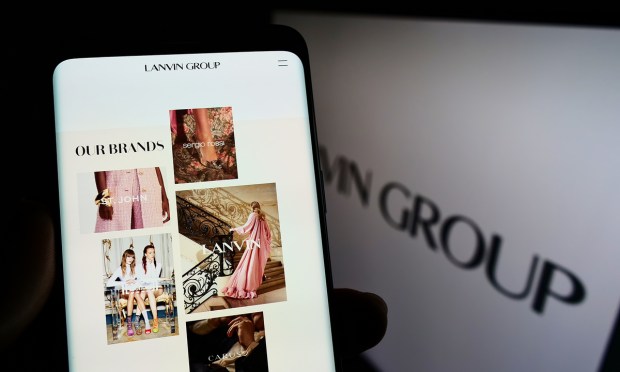High Fashion’s Digital Transformation Taking More Measured, Experimental Approach

Luxury is tactile, flooding the senses with feel, fit, look and other qualities not well conveyed by eCommerce. Be that as it may, luxury brands are making a digital transformation alternately in big moves and baby steps as upscale retail reinvents itself for new digital shopping habits.
Latest up is Lanvin Group — owner of Lanvin apparel, Sergio Rossi footwear, Wolford bodywear, St. John Knits and Caruso men’s fashion — establishing a store on the Shopify platform as it seeks digital revenue streams from new markets.
“The new digital platform powered by Shopify’s high performing and trusted technologies will allow the brands to focus on what matters the most — products and customers — and to continue their expansion with the assurance and support of a robust commerce engine in the years to come,” per a press release
See also: Shopify to Power Luxury Brand Lanvin’s Digital Store
Along similar lines is the April partnership announcement between FARFETCH and the Neiman Marcus Group (NMG), parent of Neiman Marcus and Bergdorf Goodman.
Per that announcement, “NMG will utilize FARFETCH Platform Solutions (FPS) to re-platform the Bergdorf Goodman website and mobile application. As a result, Bergdorf Goodman will introduce its digital customer experience and curated offering to customers globally, integrating seamlessly with the iconic New York City flagship.”
While some see luxury’s forays into digital as trailing despite two years of intense retail and brand investments in online, others see a sector built on rarity, exclusivity and high prices seeking a fit in an ecommerce world dominated by discount-happy marketplaces.
See also: Farfetch to Pump Money and Punch Into Neiman Marcus and Bergdorf eCommerce Ops
Upmarket Standouts
There are standouts far ahead the curve. Tiffany’s engagement ring finder app that first debuted in 2010 today enables shoppers to use augmented reality (AR) to size rings before a store visit, which is implied but not purely necessary.
Understanding the core tangible appeal of luxury goods, several brands in the space are choosing an omnichannel focus with physical retail often the endpoint of an online journey.
Analytics Insight reported in January how Burberry is using major social media sites and its stores to collect data so customers can “digitally share their purchasing preferences, experiences, and purchase history so when approached in an offline store, sales associates could use a tablet to access information in real-time and offer better-informed suggestions.”
“Burberry saw an 11% increase in revenue and a 14% increase year over year as a result of these and other digital efforts,” by bridging digital and physical in this way, it said.
Some believe that luxury will never fully migrate online due to its core appeals.
In an interview with Vogue Business in April, Scalefast Founder and CEO Nicolas Stehle said, “In e-commerce, one size does not fit all. A company like Chanel will never sell all of its products online. I don’t believe that’s the experience they want to provide to their clients.”
Dressing for the Metaverse
Many luxury brands seem more interested in the metaverse as their digital endgame, seeing its immersive nature as more in line with their upscale image and wish for consumer interaction.
Estimating that Gen Z consumers will be making 20% of luxury goods purchases by 2025, the Financial Times reported in January that “To reach them, brands will invest further in gaming partnerships (Fortnite, Honor of Kings) and NFTs,” adding that “Dolce & Gabbana set a record when it auctioned off a nine-piece collection of NFTs for $6m in September; a Morgan Stanley report boldly predicts that metaverse gaming and NFTs is a €50bn annual revenue opportunity for luxury companies, and could offer a 25 percent uplift to industry profits by 2030.”
In 2021 the North Face x Gucci collection debuted in the Pokemon Go App, giving people the opportunity to outfit avatars in “items designed from the line’s T-shirts, hats and backpacks.”
Fashion house Balenciaga partnered with proto-metaverse gaming platform Fortnite last year to debut Balenciaga Fit Set of outfits “for four of Fortnite’s fan-favorite characters – Doggo, Ramirez, Knight, and Banshee. The new Outfits are completed with new Balenciaga backblings, pickaxes, and more for players to express themselves in completely unique ways.”
Beyond luxury themed NFTs and designer clothes for avatars, luxury brands see blockchain as central to digital plans going forward. In 2021, LVMH, Cartier, PRADA Group, Richemont and OTB joined in creating the Aura Blockchain Consortium for authentication and traceability.
See also: LVMH Achieves Double-Digit Growth in Most Groups, Regions
In January, the consortium launched its Aura SaaS solution, calling it “the first blockchain based platform designed for luxury brands to help the luxury industry to embrace the blockchain in their day-to-day business operations including: supply chain, customer service, marketing, manufacturing, sustainability, purchasing, logistics, and legal.”
Per a press release, “Aura SaaS will allow Aura member brands to quickly and easily onboard, maximising value focusing on the customer journey and digital innovation and allowing for both upstream and downstream traceability in the supply chain for consumers – making it one of the best direct to consumer offerings in the market.”
Related: What’s a Metaverse, and Why is One Having a Fashion Show?
